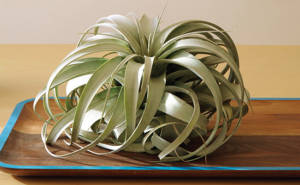
A Beginner’s Guide To Air Plants
Air plants are one of our favorite gardening trends– they add a chic, boho look to interiors but they require almost no effort. The ultimate low maintenance plant, air plants are ideal for the black-thumbed gardener who still wants to enjoy some green– or for those want to add a touch of nature to unusual spaces. We found this feature with all the air plant basics on The Knot‘s new home decor page, The Nest, and we think it’s the perfect starting place for those who want to get into the wild world of air planting. Check out this quick, handy reference guide by Alexis Jonnson, below.
With their edgy look, otherworldly air plants are the rock stars of greenery. They’ll help bring the party to your home, but they’re not a high-maintenance set. In fact, air plants don’t need soil and don’t need to be watered much, which means you can admire them without worry during busy days.
Their sunny side: Tillandsias, known as air plants, do have roots, but they don’t use them to obtain nutrients. With the right amount of direct sunlight and hydration (think a daily light misting), their leaves take care of that.
Air plants have made a major comeback since their popularity blossomed back in the ’70s.
Take two: Air plants have made a major comeback since their popularity blossomed back in the ’70s. There are two main types. Xeric Tillandsias flourish in super dry and hot locales (think the desert), and they have a furry looking surface that absorbs light and water. Whereas Mesic Tillandsias grow in more moderate climates that receive a little more moisture (think Central America). This variety has a smooth, porous surface.
Location, location, location: In nature, air plants grow on rocks, as well as on trees and other plants without harming them. At home, you can showcase them in bowls, on trays or in hanging glass globes.
via The Nest


































